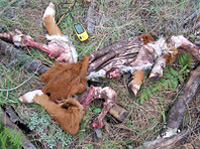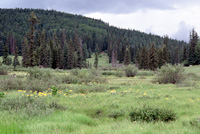Working Together
Wolves are adaptable. They don’t require habitat management or manipulation to succeed. Rather, their interactions with humans make successful reintroduction a challenge. Agencies work together to manage interactions among wolves, livestock, and people, and have specific Standard Operating Procedures in place to guide them.

Photo Courtesy of the Interagency Field Team
Biologists and agency officials review all cases of possible depredation. They proved that this calf was killed and eaten by wolves.

The rate of wolf interactions with livestock and people is higher in most of the Blue Range Wolf Recovery Area than it is in other areas of the country where wolves have been reintroduced.
Photo Courtesy of George Andrejko, Arizona Game and Fish Department
In most of the Blue Range Wolf Recovery Area, cattle graze all year on public lands. Year-round grazing gives wolves more opportunities to encounter livestock. Wildlife services personnel have documented about 70 probable or confirmed depredations or livestock injuries since 1998. Reports are investigated by the USDA Wildlife Services as soon as possible, usually within 24 hours of the incident. Occasionally, suspected wolf depredations are the result of lion, bear, domestic dog or coyote kills, or other causes of death. When petitioned by livestock owners, an organization, Defenders of Wildlife, reimburses owners for the cost of livestock lost to confirmed wolf depredations.

Released wolves are conditioned to avoid humans. However, they can become habituated to humans if fed - as can bears, foxes and coyotes.
Photo Courtesy of George Andrejko, Arizona Game and Fish Department
Wolves defend their areas against coyotes and dogs, so people who walk with dogs in the Blue Range Wolf Recovery Area should take precautions and be aware of the potential for conflict. If a wolf is seen near livestock, owners can scare it off by yelling, chasing, and throwing objects near but not at it. Owners also can discharge firearms, but not in the direction of the wolves. Agencies are continuing to research methods to minimize damage caused by wolves.
Keeping Track

Program biologists use mules to transport wolves to release sites in roadless areas.
Photo Courtesy of George Andrejko, Arizona Game and Fish Department
Wolves deemed eligible are released in the Primary Recovery Zone within the Blue Range Wolf Recovery Area. After release, biologists continue to closely monitor the wolves. All adult-sized wolves are fitted with radio collars before they are released. In addition, biologists place radio collars on some wild-born wolves that are captured after reaching adulthood. Biologists use radio signals emitted from the collars to track and record the wolves’ movements. This helps biologists monitor the wolves, including identifying denning locations to monitor reproduction, monitoring the movements of packs, and tracking locations of specific wolves when suspected depredation occurs.

Photo Courtesy of George Andrejko, Arizona Game and Fish Department
Wolves that injure or kill livestock three times within a 365-day period are removed from the wild. Removal methods are guided by Standard Operating Procedures and include either relocation to another part of the Blue Range Wolf Recovery Area or permanent removal (permanently returned to captivity or euthanized). Since the reintroduction of wolves in 1998 through March 2007, 52 wolves have been removed after killing livestock.